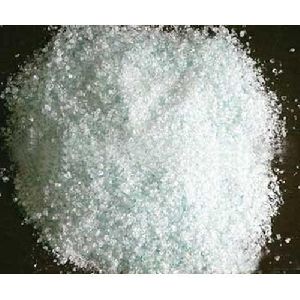
Get Price Quote
Hydrated Sodium Calcium Alumino Silicate, HIGH YIELD BENTONITE POWDER

Detergents Grade Salt
Get Price Quote
5 Ton (MOQ)
Best Deals from Detergent Raw Materials

Soda Ash
Get Price Quote
The synthetic Soda Ash is produced using the ammonia-soda process, popularly known as the Solvay process. Common salt and limestone are the raw materials processed and converted into soda ash and calcium chloride. Soda Ash Dense is a white, odorless, uniform product, free from dirt and other foreign matter. Our Soda Ash has a tendency to absorb moisture from the atmosphere. The moist Soda Ash then starts absorbing the atmospheric carbon dioxide. This phenomenon of absorption of moisture and carbon dioxide by Soda Ash is known as weathering, after such weathering, Soda Ash is likely to contain appreciable moisture and sodium bicarbonate. However, the total alkali content of the bag does not change. Soda Ash has a tendency to cake when in content with moisture and consequently becomes lumpy. Our Soda Ash is available in 2 grades: Soda Ash Dense (SODA SOLVAY® DENSE) which is produced both in Europe and in the USA and Soda Ash Light (SODA SOLVAY® LIGHT). Soda Ash Dense : The dense grade has a bulk density of ~1 t per m3 and a Particle-Median-Diameter (D50) of 300 to 500 microns. Soda Ash Dense is the grade preferred for glass manufacture because its granular properties make it dust-free and reduce the risks of segregation during transport and handling. Application : Dense Soda Ash is one of the most important basic industrial chemicals and thus finds use in glass, silicate, ultramarine, bi-chromate and other industries. Storage : Soda Ash should be stored under cover in a cool, dry place and the bags should not be stacked more than 15 high Soda Ash Light : The light grade has a bulk density of ~0, 5 t per m3. The D50 of approximately 100 microns is very well suited for detergent and chemical applications. Application : Light Soda Ash is one of most important basic industrial chemicals and the most widely used fixed alkali for manufacture of other alkali products, sodium salts, glass, soap, sodium silicates, detergent, bicarbonate, pulp and paper, cellulose and rayon, iron and steel, aluminum, cleaning compounds, water softening chemicals, textiles and dyestuffs, drugs and many other materials. It also finds extensive use as an alkali for household purposes and as a washing powder by laundries and washer men. Storage : Soda Ash should be stored under cover in a cool, dry place and the bags should not be stacked more than 15 high.

Sodium Silicate
Get Price Quote
Basic Information Sodium silicate is the common name for compounds with the formula Na2(SiO2)nO. A well-known member of this series is sodium metasilicate, Na2SiO3. Also known as waterglass or liquid glass, these materials are available in aqueous solution and in solid form. The pure compositions are colourless or white, but commercial samples are often greenish or blue owing to the presence of iron-containing impurities.They are used in cements, passive fire protection, textile and lumber processing, refractories, and automobiles. Sodium carbonateand silicon dioxide react when molten to form sodium silicate and carbon dioxide: Na2CO3 + SiO2 → Na2SiO3 + CO2 Sodium silicate is one of several chemicals that are composed of sodium, silica, and oxygen. The term is often used to indicate sodium metasilicate, which is also known as liquid glass. Sodium silicate melts at a very high temperature, making it useful for commercial fire-proofing. A sodium silicate compound contains sodium oxide, Na2O, and silica, Si2O, or a mixture of these compounds. They can be associated with up to nine molecules of water, or lack water and be known as anhydrous. These compounds can be solid, or they can be liquids. The solid version is widely used to make silica gel — a common drying agent.The combination of being liquid and being resistant to high heat makes these compounds useful for automobile repair. A sodium silicate solution is circulated from the radiator to seal leaks in the head gasket. This solution can also be used instead of motor oil to permanently disable a car engine prior to the auto’s destruction. The liquid version is also useful to treat concrete to make it more water repellent. Sodium silicate water solutions bind solids well, forming insulation boards that tolerate high temperatures. This property enables them to be used to as a refractory—retaining strength at high temperatures. Due to this, they can be used as linings in kilns and glass-making equipment. If water-proofed, they can be used as passive fire protection, such as being incorporated into the structure for plastic pipes, to form firestop devices. Sodium meta silicate is a strong base that is used in a variety of detergents as a substitute for phosphates, which have been responsible for a great deal of water pollution, by causing algae blooms. It acts primarily by changing the pH of the water to inactivate water hardness. Technically, it is known as a builder. Another sodium silicate compound is sodium aluminum silicate, which is also known as sodium aluminium silicate. It is composed of sodium, silica, oxygen, and aluminum. It can also be found in an anhydrous form, or combined with water. Sodium aluminum silicate can form very attractive minerals, including jadeite, which comprises one form of the gemstone jade. Another mineral is albite. These minerals are anhydrous. There is a synthetic, industrial form of sodium aluminum silicate that contains water. It is known as synthetic amorphous sodium aluminosilicate. This is a common food additive, used as an anti-caking agent that keeps powdered foods free of lumps. USES of Sodium Silicate: Adhesive The largest application of sodium silicate solutions is a cement for producing cardboard. When used as a paper cement, the tendency is for the sodium silicate joint eventually to crack within a few years, at which point it no longer holds the paper surfaces cemented together. Drilling fluids Sodium silicate is frequently used in drilling fluids to stabilize borehole wells and to avoid the collapse of bore walls. It is particularly useful when drill holes pass through argillaceous formations containing swelling clay minerals such as smectite or montmorillonite. Detergent auxiliaries It is used in detergent auxiliaries such as complex sodium disilicate and modified sodium disilicate. The detergent granules gain their ruggedness from a coating of silicates. Water treatment Water glass is used as coagulant/deflocculant agent in wastewater treatment plants. Waterglass binds to colloidal molecules, creating larger aggregates that sink to the bottom of the water column. The microscopic negatively charged particles suspended in water interact with sodium silicate. Their electrical double layer collapses due to the increase ofionic strength caused by the addition of sodium silicate (doubly negatively charged anion accompanied by two sodium cations) and they subsequently aggregate. This process is called coagulation/deflocculation. Refractory use Water glass is a useful binder of solids, such as vermiculite and perlite. When blended with the aforementioned lightweight aggregates, water glass can be used to make hard, high-temperature insulation boards used for refractories, passive fire protection and high temperature insulations, such as moulded pipe insulation applications. When mixed with finely divided mineral powders, such as vermiculite dust (which is common scrap from the exfoliation process), one can produce high temperature adhesives. The intumescence disappears in the presence of finely divided mineral dust, whereby the waterglass becomes a mere matrix. Waterglass is inexpensive and abundantly available, which makes its use popular in many refractory applications. Dye auxiliary Sodium silicate solution is used as a fixative for hand dyeing with reactive dyes that require a high pH to react with the textile fiber. After the dye is applied to a cellulose-based fabric, such as cotton or rayon, or onto silk, it is allowed to dry, after which the sodium silicate is painted on to the dyed fabric, covered with plastic to retain moisture, and left to react for an hour at room temperature. Food preservation World War I poster suggesting the use of waterglass to preserve eggs (lower right).Sodium silicate was also used as an egg preservation agent through the early 20th century with large success. When fresh eggs are immersed in it, bacteria which cause the eggs to spoil are kept out and water is kept in. Eggs can be kept fresh using this method for up to five months. When boiling eggs preserved this way, it is well advised to pin-prick the egg to allow steam to escape because the shell is no longer porous. Metal Repair Sodium silicate is used, along with magnesium silicate, in muffler repair and fitting paste. When dissolved in water, both sodium silicate and magnesium silicate form a thick paste that is easy to apply. When the exhaust system of an internal combustion engine heats up to itsoperating temperature, the heat drives out all of the excess water from the paste. The silicate compounds that are left over have glass-like properties, making a temporary, brittle repair. Safe construction A mixture of sodium silicate and sawdust has been used in between the double skin of certain safes. This not only makes them more fire resistant, but also makes cutting them open with an oxyacetylene torch extremely difficult due to the smoke emitted. Crystal gardens When crystals of a number of metallic salts are dropped into a solution of water glass, simple or branching stalagmites of coloured metal silicates are formed. This phenomenon has been used by manufacturers of toys and chemistry sets to provide instructive enjoyment to many generations of children from the early 20th century until the present. An early mention of crystals of metallic salts forming a “chemical garden” in sodium silicate is found in the 1946 Modern Mechanix magazine.[15][/15] Metal salts used included the sulfates and/or chlorides of copper, cobalt, iron, nickel, and manganese.

Sodium Silicate Powder
Get Price Quote

Soda Ash Light
Get Price Quote
Soda Ash Light, Pure Yellow Maize

Soda Ash Light
Get Price Quote
Liquid Sodium Silicate, Non Ferric Alum, Edible Refined Salt

Soda Ash
Get Price Quote
Soda Ash, Cement, Bentonite Powder, Cement Clinker, Industrial Salt

Soap Stone Powder
Get Price Quote
Bentonite Powder, red oxide pigments, Calcite Powder, China Clay, Cat Litter

Soda Ash Light
Get Price Quote
Soda Ash Light, Glauber Salt

Soap Scrap
Get Price Quote
Glycol

Soap Noodles
Get Price Quote
Soap Noodles

Soda Ash Light
Get Price Quote
Soda Ash Light, Bentonite Powder, Home Decorative Item, Cattle Feed

Sodium Carbonate
Get Price Quote
Sodium Carbonate, Silica, Red Ocher Powder, Barytes Powder

Soda Ash
Get Price Quote
Soda Ash

Palm Oil
Get Price Quote
pluses, Edible Oil

Soap Noodles
Get Price Quote
Soap Noodles, Sulphuric Acid

Palm Oil
Get Price Quote
Soyabean Oil, Cooking Oil, bakery biscuit, Cotton Oil, vanaspati oil

Soda Ash Light
Get Price Quote
Distilled Soya Fatty Acid, Ricinoleic Acid